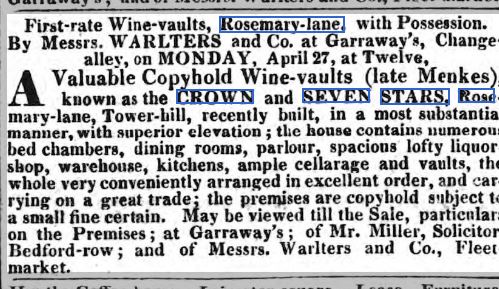The Artful Dodger (formerly the Crown and Seven Stars)
1825–6, public house, altered 1881 and 1888, renamed 1985
47 Royal Mint Street (formerly the Crown and Seven Stars public house, now the Artful Dodger)
Contributed by Survey of London on May 1, 2019
By 1730 there was a public house called the Half Moon and Seven Stars on Rosemary Lane in Whitechapel, perhaps on this site,the Rosemary Lane corner of Blue Anchor Yard. Confusingly, there was another pub called the Seven Stars a short distance to the west on the same side of Rosemary Lane but outside Whitechapel; Seven Stars Alley or Court lay west of Cartwright Street. The name doubtless refers to the seven-starred constellation known as the Plough. In 1715 Ned Ward had written of the Seven Stars, ‘Near to the Place where Frippery-Women stand/with Stays, Coats, Suits, and Breeches second hand,/Where rags of every sort and size are sold and/Thieves their daily correspondence hold,/There stands a House, Wherein if fame not lies/The Stars at Noon-day to Men’s sight arise’.1
The Crown and Seven Stars was firmly established at this site by 1790. It was rebuilt in 1825–6 when proprietorship passed from Catherine Collins to Diederich Menke, a German victualler who ran a pub in Norton Folgate. Menke died within months of being imprisoned for debt in 1828. These ‘wine-vaults’ were advertised in 1829 as ‘recently built, in a most substantial manner, with superior elevation, . . . spacious lofty liquor shop, warehouse, kitchens, ample cellarage and vaults’.2
The front of the four-storey pub was partially rebuilt in 1881 for George Frederick Buckingham, with J. & H. Cocks of the Mile End Road as builders. Buckingham was much exercised at this time about the loss of business caused by Metropolitan Board of Works clearances and delays over housing redevelopment. This is probably when the façade gained its bravura display, prominently visible from the nearby railway, and so presumably hoping to draw custom. A giant order of Ionic pilasters supports a sub-Corinthian attic in which there sits a central crown haloed by seven stars. Inscribed friezes advertise ‘WAREHOUSE.’ above ‘WHOLESALE & RETAIL.’. Despite this, Buckingham’s losses obliged him to close the pub. Further alterations in 1888 included a bar and shopfront for Frederick John Vinall and the Cannon Brewery Company, to designs by J. C. Reynolds, a pub architect with links to that brewery who had long been the surveyor to Camberwell vestry; J. & H. Cocks were again the builders. The ornamental ground-floor cast-iron columns, enriched with bunch-of-grape and pineapple capitals, an ornate frieze, the largely glass ground-floor front with canted recesses and the first-floor balcony appear to be from this date. A ground-floor dining room and WCs followed in 1892–4, now with Richard E. Small of Clerkenwell as builder.3
The pub was incorporated into the Greater London Council’s plans for building the Royal Mint Estate and listed in 1974, but with its environs cleared it closed in 1981. In 1985, when the completed Royal Mint Estate at last promised new business, it reopened, renamed the Artful Dodger as if to cling to Cockney identity.4
-
Edward Ward, A vade mecum for malt-worms: or, A guide to good fellows, 1715, p. 16: London Metropolitan Archives (LMA), MR/LV/05/026 ↩
-
Morning Advertiser, 29 Dec 1827, p. 4; 14 April 1829, p. 4: Public Ledger and Daily Advertiser, 12 May 1828, p. 3: London Evening Standard, 27 Jan. 1829, p .3: LMA, CLC/B/192/F/001/MS11936/366/567713;/377/582472 Land Tax returns ↩
-
Metropolitan Board of Works Minutes, 4 March 1881, p. 382; 23 June 1882, p. 1032; 22 June 1888, p. 1093: LMA, District Surveyors Returns: The Builder, 1 Dec 1888, p. 403: Post Office Directories: Tower Hamlets Local History Library and Archives, L/THL/D/2/30/129: LMA, LMA/4433/D/03/024: Historic England Archives, London Region Historians’ file TH23 ↩
-
https://pubshistory.com/LondonPubs/Whitechapel/CrownSevenStars.shtml: Stephen R. Harris, https://surveyoflondon.org/map/feature/1340/detail/#note] ↩
The Crown and Seven Stars, 1975
Contributed by Survey of London on Jan. 23, 2017
A digitised colour slide from the Tower Hamlets Archives collection showing the Artful Dodger when it was still the Crown and Seven Stars, in 1975
1891
Contributed by JVinall on May 3, 2017
The 1891 census shows that William Vinall was the innkeeper here with his wife Alice Tigwell. We believe that his father Fred Vinall, who later kept the Old Bull and Bush (Hampstead) in the days of the music hall song, was the actual leaseholder or owned the freehold. My husband's father, Albert Sidney, was born at the Crown and Seven Stars in 1901 and often visited his grandfather at the Old Bull and Bush where he also ran errands for the ballerina Anna Pavlova.
The Crown and Seven Stars
Contributed by Survey of London on Jan. 25, 2017
There was a public house of the name Crown and Seven Stars at the corner of Blue Anchor Yard and Rosemary Lane (the name of Royal Mint Street until the late 1850s) by 1790.1 The present building was described as 'recently built... with superior elevation' in 1829.2
The signage on the front suggests reuse of an existing building, but it seems likely, given that the premises included a warehouse in 1829, that it refers to use of part of the building for the retail and wholesale sale of wines and spirits concurrent with its use as a public house which has apparently been unbroken since 1790. The pub was renamed the Artful Dodger in 1985.3
-
London Metropolitan Archives, Sun Fire Office records, CLC/B/192/F/001/MS11936/366/567713 ↩
-
Morning Advertiser, 14 April 1829, p. 14 ↩
-
http://pubshistory.com/LondonPubs/Whitechapel/CrownSevenStars.shtml ↩
Some historical notes on the Artful Dodger
Contributed by stephen.r.harris on Jan. 30, 2017
I have an unsubstantiated note that this pub was present in Rosemary Lane by 1764. But the early history of the pub is confused by the possibility that there may have been another pub in Rosemary Lane called the Seven Stars (the address of the Crown & Seven Stars seems to have been given consistently as 47 Rosemary Lane, whilst I have the other Seven Stars as at 22 Rosemary Lane - but these could well have been one and the same premises).
The first licensee I have been able to name is George Beaumont, who in 1803 held an insurance policy on the Crown & Seven Stars with the Sun Fire Office.
The impressive relief of a crown and seven stars at the top of the building is said to have been added to the frontage in 1888, the work of one C J Reynolds - and it seems likely that the words 'Warehouse' and 'Retail & Wholesale' date also from this time. This old signage has led some to conclude that the building served formerly as a warehouse of some sort before it became a pub; but these are in fact routine words used to describe a fully-licensed pub that also sold wine and spirits on a wholesale basis, a trade which would have been important for a pub located so close to the docks. The attractive ground- floor frontage with its cast iron columns may also date from this time.
The pub became tied to the Ind Coope Brewery, but closed in 1981. It re- opened, following substantial refurbishment, as the Artful Dodger some four years later in September 1985.
St Marks House
Contributed by julie3 on Nov. 29, 2018
Opposite the Artful Dodger pub was St Mark's House originally St Mark's School built c.1841. It closed in 1939. In 1945 it was purchased by Freimullers Ships Stores. Eventually, St Mark's House was demolished to make way for the Docklands Light railway, approx mid 1980's .
1754: Theft at the Blue Anchor
Contributed by stephen.r.harris on Dec. 16, 2016
On 27 February 1754 the Old Bailey heard the case of Gerrard Gervise, accused of theft from the Blue Anchor public house in Whitechapel (at that date the only pub of that name in the parish was on Rosemary Lane, present-day Royal Mint Street). The full account can be read on the Proceedings of the Old Bailey website.1 Gervise was accused of stealing eight and a half guineas, seven shillings and sixpence, plus two gold rings, from pub licensee William Hall. The court heard that Gervise had lodged at the pub for several days in advance of going to sea. On the day of his departure, William Hall found the money and rings missing from the drawer where they had been kept and confronted Gervise, having heard that the latter had just purchased two silver buckles at Mr Bond's shop in Whitechapel. Gervise confessed all when arrested, saying that as well as the buckles, he had bought a wig, a hat, a coat, a waistcoat and some breeches. But in court he claimed he had been given the money by his aunt to buy clothes for his sea voyage and that the rings were his family's. He was found guilty of theft and sentenced to transportation.
-
https://www.oldbaileyonline.org/browse.jsp?id=t17540227-49&div=t1754 0227-49 ↩
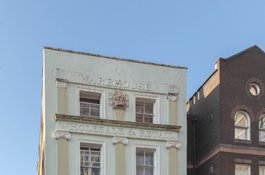
The Artful Dodger in 2019
Contributed by Derek Kendall
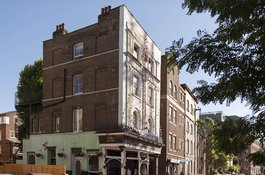
The Artful Dodger and 39–45 Royal Mint Street from the northeast in 2018
Contributed by Derek Kendall
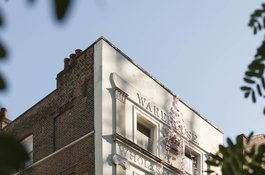
The Artful Dodger in 2018
Contributed by Derek Kendall
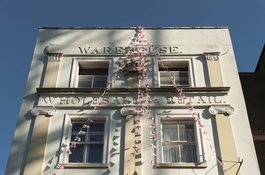
The Artful Dodger, detail of upper storeys of facade in 2018
Contributed by Derek Kendall
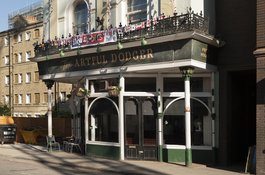
The Artful Dodger, detail of fascia in 2018
Contributed by Derek Kendall
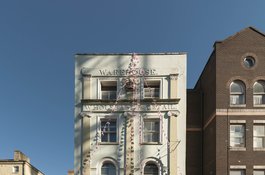
The Artful Dodger in 2018
Contributed by Derek Kendall
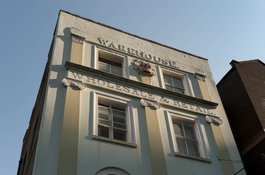
Former Crown and Seven Stars, detail of facade in 2019
Contributed by Derek Kendall
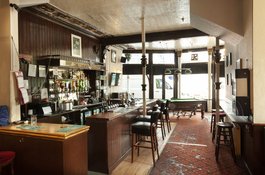
Artful Dodger, interior from the south in 2019
Contributed by Derek Kendall
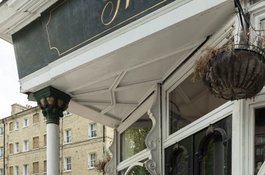
Artful Dodger, detail of northeast corner in 2019
Contributed by Derek Kendall
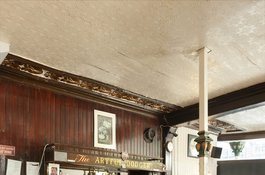
Artful Dodger, interior view of bar in 2019
Contributed by Derek Kendall
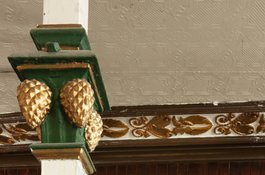
Artful Dodger, interior details in 2019
Contributed by Derek Kendall
